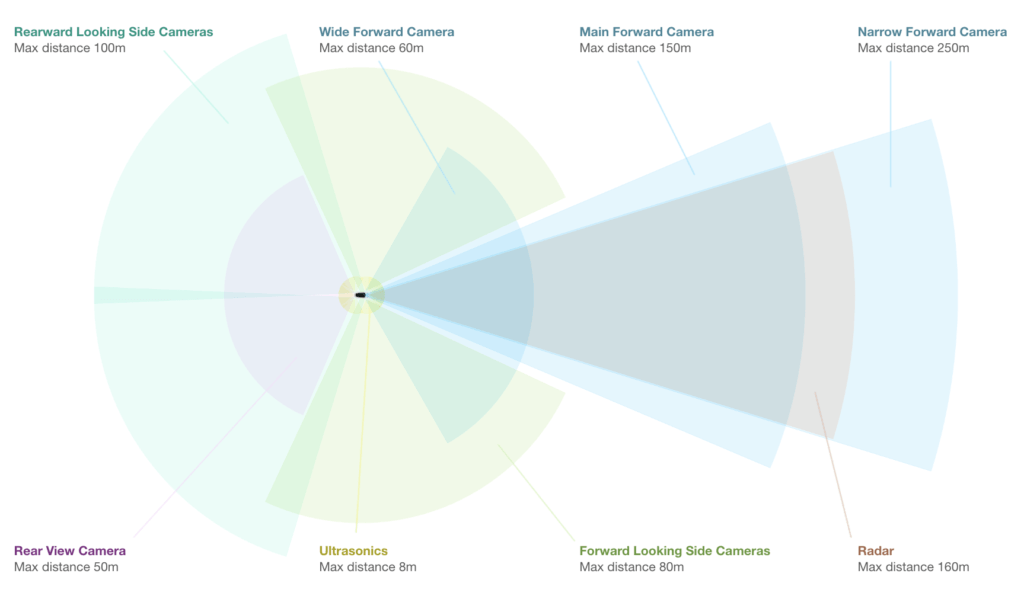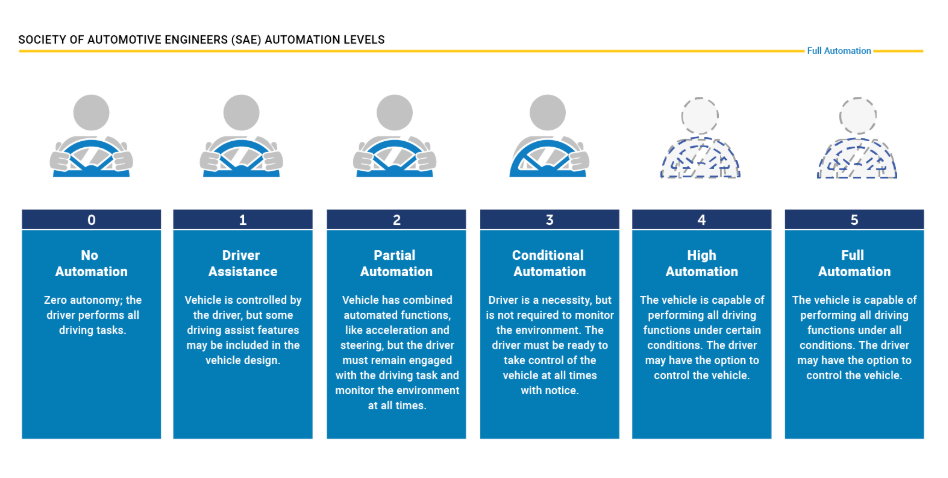Tesla: How Machines Are Now Driving Our Cars

Autonomous driving is a form of applied machine learning that allows computers inside the car to process and recognize driving conditions in real-time. This paper explores how Tesla is bringing autonomous driving to the masses via its substantial machine learning network.
Autonomous Driving & Machine Learning
Autonomous cars are starting to show up on our roads – Google, Uber, Lyft, Tesla, and many of the traditional automotive OEMs have started testing and releasing early-phase autonomous cars. This trend of autonomous driving will continue and will spur massive changes to our transportation networks, cities, and societies.
Self-driving cars function by having an array of radar and ultrasonic sensors capture vast amounts of data about its operating environment to process in real-time and send control instructions to the steering system of the vehicle. Current Tesla vehicles blend together a variety of sensors including cameras, radar, and ultrasonics (Figure 1) to monitor their surroundings. The heart of this functionality lies in the applied machine learning algorithms that take in disparate data sets and output driving commands that allow the car to follow the road and adhere to its laws.
Figure 1: Source: Image from Tesla Autopilot Website https://www.tesla.com/autopilot
The data processing referenced above can be split into two parts: 1) the on-machine portion 2)the cloud.
On-machine refers to the processing that happens in real-time on the car in order make the control decisions. As was mentioned above, the images from the cameras and radar are combined to allow the car to understand its environmental constraints and produce a set of outputs to control the speed, acceleration, and direction of the vehicle.
Separately, Tesla unleashes the power of machine learning in the cloud2. The machine learning network is a massive neural network project that takes data from all Tesla vehicles and uploads them to the cloud for processing. The hundreds of sensors on each car will capture driving data that can then be fed into the machine learning algorithms which operate in data centers around the world. These algorithms learn from the success and failures of each individual car to continuously refine how the onboard computers respond to data inputs.
Implications of Machine Learning at Tesla
Machine learning has enormous implications for Tesla. Having the greatest number of vehicles on the road with Autopilot systems allows them to capture far more information than their competitors. In a report by McKinsey & Co1, the automotive big data business could be worth $750 billion by 2030 and Tesla by virtue of being a first-mover in this space could be well positioned to capture a vast portion of that market.
The Society of Automotive Engineers publishes a model of autonomous driving that shows the level of attention required from the driver (Figure 2). Tesla vehicles currently offer Level 2 autonomous driving which still requires attention from the driver. However, Tesla is on the verge of releasing Version 9 of its Autopilot program this year, which will usher in the era of Level 3 autonomous driving for the masses – still requiring drivers to be present, however, not requiring drivers to actively monitor the environment.
Figure 2: Source: Image from National Highway Traffic Safety Administration (NHTSA) Website https://www.nhtsa.gov/technology-innovation/automated-vehicles-safety
In the near term, Tesla will need to deliver on their plan to reach Level 5 Full Autonomous driving and they will do so by taking their learnings from their massive neural network and feeding that right back into the developmental process. In the long term, Tesla will need to work with governments, infrastructure development firms, and the rest of the automotive industry to build out smart infrastructure that will allow further networked communications to keep cars safe on the road and reduce the level of congestion in cities.
Recommendations
While Tesla has a strong lead in the number of vehicles on the road, which allows them to collect large amounts of data, they will need to be aware of the limitations of the technology. Many have accused the company of being deceptive with their marketing, leading to deaths of drivers that believed their cars were fully autonomous. This is a challenge that Tesla needs to work on as safety should be their number one concern.
The Future
The Trolley Problem3 is a common thought experiment in ethics that applies directly to machine learning: You see a runaway trolley moving towards a group of five people, while a lone person stands off to the side. You have the option to pull a lever to redirect the trolley to the lone person and save the lives of the five people that it’s currently aimed at. What do you do? This is the exact type of question that a machine learning algorithm will have to solve. If you were put in this situation, what would you do? (752 words)
Citations
1 Michele Bertoncello et al., “Monetizing car data New service business opportunities to create new customer benefits,” McKinsey & Co., [https://www.mckinsey.com/~/media/McKinsey/Industries/Automotive%20and%20Assembly/Our%20Insights/Monetizing%20car%20data/Monetizing-car-data.ashx], accessed November 2018.
2 Bernard Marr, “The Amazing Ways Tesla Is Using Artificial Intelligence And Big Data”, Forbes, January 8, 2018, [https://www.forbes.com/sites/bernardmarr/2018/01/08/the-amazing-ways-tesla-is-using-artificial-intelligence-and-big-data/], accessed November 2018
3 Judith Jarvis Thomson, The Trolley Problem, 94 Yale Law Journal 1395–1415 (1985)





Very well-written article. This is a very controversial topic and the way you finish the article – with the question directed to a human on what he/she would do – goes direct to the point I would like to bring. I can relate this to the situation of being robbed and asked not to react. The reality is that you simply don’t know how you are going to react until that happens to you (and even in this case I believe that there might be many factors around you that might make you react differently in similar situations), and so how are you going to program a machine for knowing that? What is right or wrong? And how are you going to impose that decision for everyone else? I actually see the autonomous car as an opportunity to improve safety (reduce drinking & driving, avoid accidents cause for humans’ deviations such as falling asleep or getting distracted, etc) and an opportunity for us to better control the outcome of situations. While in real human interactions you can’t really predict reactions, here you have an opportunity to program and control it. But, do we want big automobile companies deciding on what is right or wrong and taking out our individual critical sense? Who is going to determine that the life of that single person matters less than the others’ lives? And how will the machine react when faced with non-programmed situations? Big question marks arise when we are faced with a big revolution (i.e. cloning and the commodification of live) and this just prove that we stand before one right now.
I found this extremely interesting as it’s something that is frequently discussed when we talk about the next wave of technology. I never had a good understanding of how autonomous vehicles would work, but after learning about machine learning and reading through this article, it makes sense. The dependency on the cloud, where Tesla is constantly collecting data from all of its driverless cars, correcting for error and enforcing success, is what seemingly driving the tech forward. With most applications of machine learning, there is this virtuous cycle, where you get more and more cars on the road, get more data, those cars learn and drive more effectively, and thus demand for autonomous vehicles goes up. The Trolley Problem is a tough one, but I think this is where we can actually see a benefit of autonomous vehicles (albeit a cold-blooded benefit perhaps) – humans might not be able to make the rational decision, but these cars will.
Such a fascinating read! The neural network project for continuous refinement of the onboard computers is especially critical; the quality of these computers has a direct and very, very real impact on the safety of the passengers. I think, for many people, the tech behind autonomous cars is beyond their comfort zone. But I wonder, with those same people deeply concerned about the safety of these vehicles, should Tesla make an effort to communicate the sophistication of their technology and data processing and, if so, how? Do they have a responsibility to make this knowledge public and accessible, so as to ease concerns and fuel buy-in in the movement towards autonomous vehicles? Would it be a benefit or waste of their time?
I’m also very interested in the ethics of this problem – some individuals think that Tesla, and similar companies employing ML systems, have a responsibility to hire Ethics Officers/Employees to oversee the salient moral implications of automating human decisions. At the same time, although there have been serious accidents, have we not already seen a massive improvement in the quality of driving among these autonomous vehicles, which would lead to a major reduction in motor-vehicle accidents? Is this also a matter of educating the public? Do we even need their understanding if this is a trend that will move forward regardless?